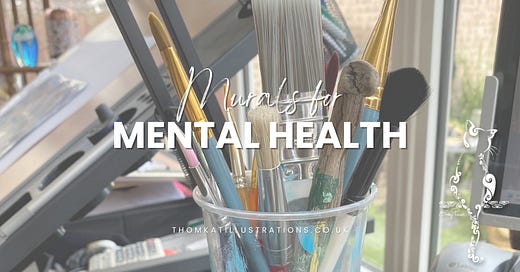Parklands Hospital in Basingstoke is home to a variety of adult mental health wards and community hubs. It’s an inpatient facility, meaning that the people supported by the hospital spend prolonged periods of time here.
Mental health is such a vast subject. Two words with so much meaning, so much reach. And so much power over our lives. When our mental health is good, the world is our oyster, we can walk on air. When it’s poor, our lives can come crashing down, just getting through the day can be a challenge.
Most of us have or will experience poor mental health at some point in our lives. Some of us for longer, and more severe than others. When that happens, receiving professional help from places such as Parklands can literally save lives.
That’s why it was such an easy ‘yes’ when they asked if I could design and paint a series of murals throughout the hospital. Hope Trees, to be inspired by the patients own words when asked what brings them hope.
As an artist, it’s pretty blooming obvious that I love art, and therefore no surprise that I find art good for my own mental health. Being surrounded by the things we love would naturally be good for anybody, right?
But did you know that recent studies have begun to prove that art really can improve our mental health and wellbeing?
Feeling good
Neuroaesthetics research conducted by Dr Semir Zeki (University College, London) has shown that when looking at art we perceive to be beautiful, there is strong activity in the part of the brain that relates to pleasure. It’s the same part of the brain that is stimulated when we look at someone or something we love. Part of the same system that releases dopamine when we do so. It’s a feel good chemical that improves our mood, gives us energy and helps us to focus.
Relax and unwind
Other studies have shown that taking in the arts can be soothing, and reduce stress levels.
For example, an experiment in 2006 by the University of Westminster took city workers into an art gallery during a 30 minute lunch time break. The drop in cortisol (the stress hormone) that the workers registered was significant and rapid, close to the drop that would usually take place over a period of 5 hours.
Ambience and atmosphere
Art has long been incorporated into healthcare environments. This is no accident. By their very nature, hospitals, surgeries and clinics can be daunting and not a place anyone really wants to be.
Often, you will see art dotted around to bring warmth and comfort to the patients. Art can be welcoming, and in turn create a safer, more familiar, relaxed ambience that feels less scary.
Simple colour is used in the same way. Blues and greens to calm and invoke a sense of security and harmony. Oranges and yellow to promote optimism, the sunshine effect. Just look around you; brand marketers, architects, interior designers, have long since been using colour to invoke particular feelings and emotions in us all.
The idea that colour and art can support healing then, doesn’t seem so farfetched.
And it’s not just for the patients. Healthcare workers can spend their days immersed in the pain and sadness of others. Art and colour can help to bring peace and comfort to their day too.
There is still so much to unpack around the impact of art on our mental health and wellbeing. It’s reasonable to say that studies are still in their infancy, but increasingly providing data that shows what a positive influence it can be.
Knowing that my murals could bring comfort, hope and peace to all those in and around Parklands Hospital is an absolute privilege.
Art is, of course, an individual experience, in that we all perceive it differently. We see and take different meanings, different messages, from the same piece.
Yet at the same time, it brings people together. Whilst we may each experience something different, we experience it together. It creates discussion, debate, mutual appreciation and a feeling of belonging.
I can’t think of a more worthy project.
Look me up here on Substack next week when I will be sharing how making art has supported my own mental health, and how it can support yours too.
Sources:






Share this post